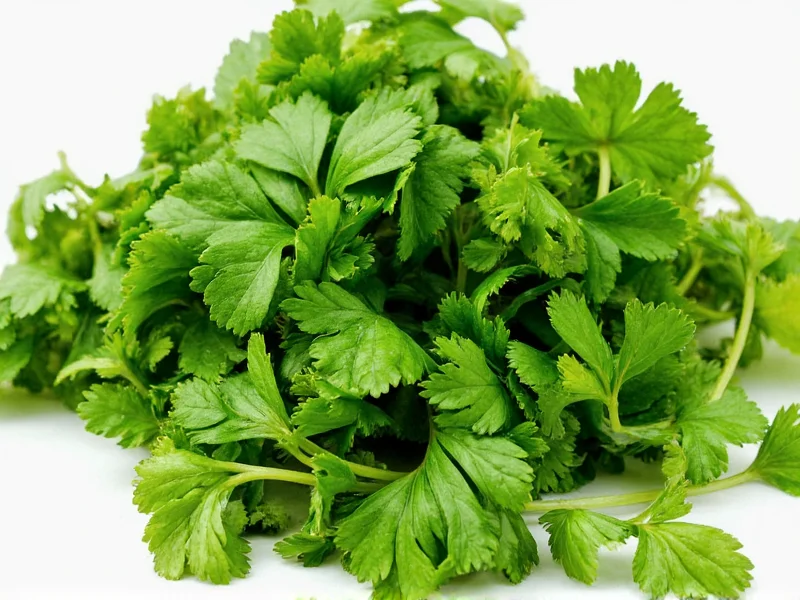Visual Identification: Telling Cilantro and Parsley Apart
Correctly identifying these herbs prevents culinary mishaps. Cilantro leaves grow in a more circular pattern with rounded, asymmetrical edges that curl slightly upward. The stems are thin and delicate, often with a light green hue. When crushed, cilantro releases a distinctive citrus aroma with earthy undertones.
Parsley presents two distinct forms. Curly parsley features tightly curled, ruffled leaves resembling miniature lettuce, while flat-leaf parsley has broader, flatter leaves with pointed tips and prominent serrations. Parsley stems are thicker and more rigid than cilantro's, often with a slightly darker green color. The scent is more neutral and grass-like compared to cilantro's pronounced fragrance.
| Characteristic | Cilantro | Parsley (Flat-Leaf) |
|---|---|---|
| Leaf Shape | Rounded with scalloped edges | Pointed with serrated edges |
| Leaf Texture | Softer, more delicate | Firmer, slightly tougher |
| Stem Appearance | Thin, light green | Thicker, darker green |
| Aroma Profile | Citrusy, pungent, sometimes soapy | Grassy, mild, slightly peppery |
Flavor Profiles and Culinary Applications
Cilantro's vibrant, citrus-forward flavor makes it essential in Latin American, Southeast Asian, and Indian cuisines. It shines in salsas, guacamole, chutneys, and Thai curries. The herb's volatile compounds break down quickly with heat, so chefs typically add cilantro at the end of cooking or as a fresh garnish. Approximately 21% of the population carries a genetic variation that perceives cilantro as tasting like soap, significantly affecting their culinary experience.
Parsley serves as a versatile culinary workhorse with two distinct varieties. Curly parsley primarily functions as a garnish due to its milder flavor and attractive appearance, while flat-leaf parsley delivers more robust flavor preferred by professional chefs. Both varieties withstand cooking better than cilantro, making them suitable for incorporation throughout the cooking process. Parsley anchors classic preparations like gremolata, persillade, and fines herbes, and enhances Mediterranean dishes, soups, and roasted vegetables.
Substitution Guidance: When and How to Swap
Understanding when to substitute parsley for cilantro prevents recipe disasters. While neither herb perfectly replaces the other, context matters:
- For cold dishes like salsas or salads where cilantro's flavor dominates, no adequate substitute exists
- In cooked dishes requiring herbal notes, use 1:1 flat-leaf parsley for cilantro with added citrus zest
- For garnishing, curly parsley can visually substitute for cilantro though flavor differs
- When avoiding cilantro's polarizing flavor, try culantro (a different herb with similar flavor but tougher leaves)
Successful herb substitution depends on the dish's cultural context and whether the herb serves as a primary flavor component or supporting note. In authentic Mexican or Thai recipes, cilantro substitution often compromises authenticity.
Nutritional Comparison and Health Benefits
Both herbs offer impressive nutritional profiles despite their flavor differences. Cilantro provides higher concentrations of vitamin K and contains compounds like linalool and geraniol with potential antioxidant properties. Research suggests cilantro may help reduce heavy metal accumulation in the body.
Parsley surpasses cilantro in vitamin C content and contains apigenin, a flavonoid studied for potential anti-inflammatory effects. Both herbs contribute negligible calories while enhancing dishes with phytonutrients. A quarter-cup serving of either herb provides approximately:
- 2-3 calories
- 10-15% of daily vitamin K needs
- 5-10% of daily vitamin C requirements
- Trace minerals including potassium and iron
Growing and Storage Techniques
Successful cultivation of growing cilantro and parsley at home requires understanding their different needs. Cilantro grows quickly but bolts (goes to seed) rapidly in warm temperatures, making it best for spring and fall planting. It prefers cooler conditions and often performs better when succession planted every 2-3 weeks.
Parsley establishes slower but persists longer through seasonal changes. It tolerates partial shade better than cilantro and typically provides harvests for 2-3 years in suitable climates. Both herbs prefer well-draining soil with consistent moisture.
For optimal freshness when storing fresh cilantro and parsley:
- Treat both herbs like cut flowers: trim stems and place in water
- Cover loosely with plastic bag in refrigerator
- Cilantro lasts 7-10 days; parsley often remains fresh 10-14 days
- Freeze chopped herbs in oil for long-term preservation
Common Culinary Mistakes to Avoid
Cooks frequently make these errors when working with these herbs:
- Using dried cilantro as substitute for fresh (drying destroys its essential oils)
- Adding cilantro early in cooking (heat diminishes its distinctive flavor)
- Confusing culantro with cilantro (different plants despite similar names)
- Washing herbs before storage (moisture accelerates spoilage)
- Using stems of flat-leaf parsley in delicate dishes (they're tougher than leaves)
Mastering the difference between cilantro and parsley elevates cooking precision. Professional chefs recommend keeping both herbs on hand as they serve distinct purposes in global cuisines. When uncertain which herb a recipe requires, consider the dish's cultural origin—cilantro appears prominently in Mexican, Indian, and Thai cooking, while parsley features in European and Middle Eastern traditions.











 浙公网安备
33010002000092号
浙公网安备
33010002000092号 浙B2-20120091-4
浙B2-20120091-4